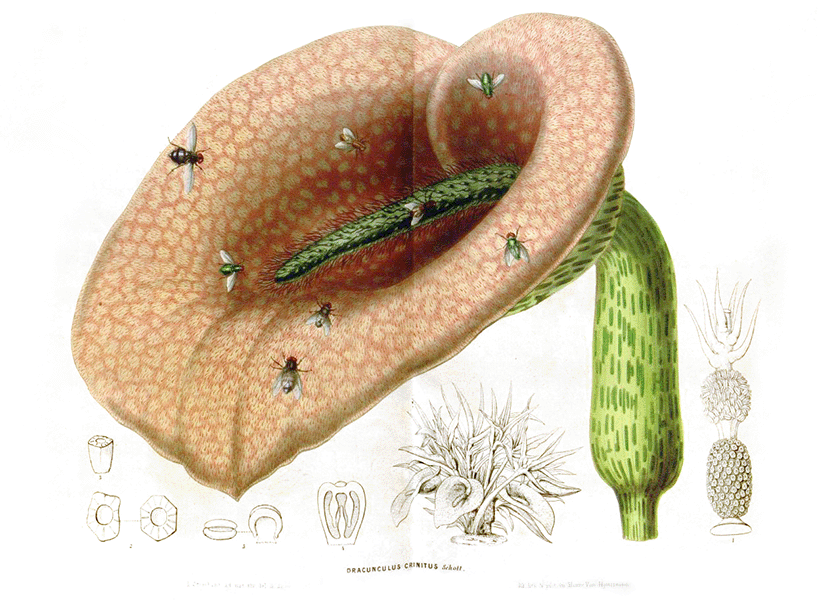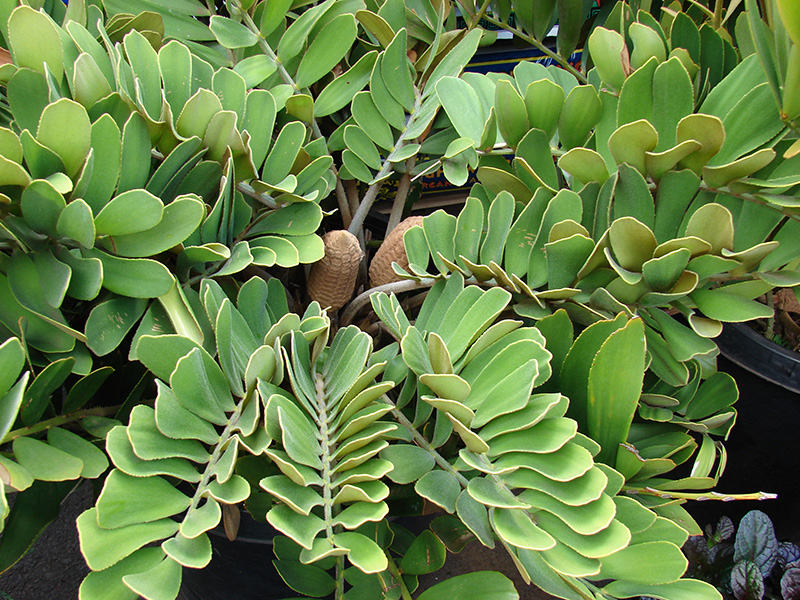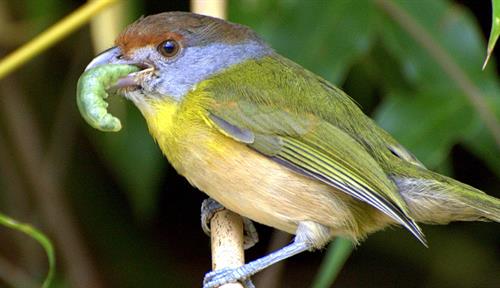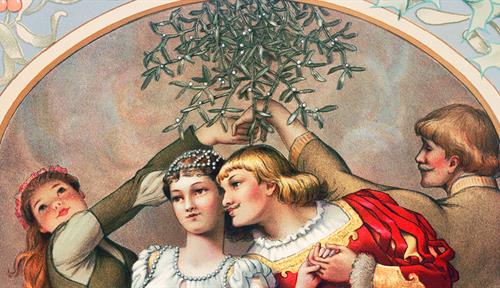Rotten tricks: How hot and stinky plants woo pollinators
To attract insects, thermogenic plants turn up the heat, emit strong odors and even disguise themselves as corpses
Support sound science and smart stories
Help us make scientific knowledge accessible to all
Donate today
In late winter, in the swampy lowlands of the northeastern United States, you might catch a whiff of rotting flesh. The unlikely source is flowers — maroon pointy things, the size of fists, that protrude from the still-frozen ground like grotesque harbingers of spring.
These are the flowers of the Eastern skunk cabbage (Symplocarpus foetidus), and flies and other pollinators are drawn by their putrid odor as well as by the flowers’ warmth. Skunk cabbage is one of a smattering of plants that can generate remarkable amounts of heat, an ability called thermogenesis: Its floral tissues can reach a toasty 84 degrees Fahrenheit (28.9 degrees Celsius), even on days that are near freezing.
It’s somewhat contentious among scientists why plants would bother to make heat: After all, the process is metabolically expensive. Yet thermogenesis has been documented in 14 different plant families, some of them with more than a hundred heat-generating species. The sacred lotus (Nelumbo nucifera) can crank up its flowers to 95°F (35°C) and maintain that heat over days; the famed giant corpse flower (Amorphophallus titanum) reaches similar steamy temperatures, generating its heat in pulses.
“Thermogenesis should be energetically costly for an organism, right? You’re just burning energy; you’re burning carbohydrates that you made,” says chemical ecologist Shayla Salzman of the University of Georgia in Athens. “So, if it is energetically costly, then it is something that you should have lost over evolutionary time — unless it had some equally valuable benefit.”
For warm-blooded animals, the benefit of a toasty body is that muscles, nerves and the brain still function, even if it’s cold out.
But for plants studied thus far, the benefit seems to be that warm flowers help them to have sex.
Scientists are beginning to get a handle on how that benefit plays out. For some plants, generating heat has been linked to preventing flower parts from freezing, while in others, heat may help to lure pollinators or encourage attractive scent chemicals to waft further afield. The more closely that scientists look at thermogenesis, the more they are discovering that it’s no blunt instrument. Rather, it’s a tool that plants wield with surprising nuance.
Among the most famous of thermogenic plants are those in the arum family (Araceae), which counts among its members skunk cabbage and the giant titan arum or corpse plant. Both these plants have large, darkly colored floral parts that, along with their heat generation, are a ruse: They are disguising themselves as decomposing carcasses and thus cozy, food-rich places to lay eggs. The hoodwinked flies or beetles crawl about and get dusted with pollen that they deliver to other flowers as their hunt continues for a proper brood site.

The dead horse arum’s scent and temperature attract blowflies by mimicking a dead, rotting gull carcass. Tiny male and female flowers grow along the structure’s central, hairy green spike, or spadix.
CREDIT: L. VAN HOUTTE / FLORE DES SERRES ET DES JARDINS DE L'EUROPE VOLUME 5 1849
In a classic experiment investigating this brood-site mimicry, as scientists call it, researchers studied the scent chemicals made by a thermogenic aroid called dead horse arum (Helicodiceros muscivorus), whose hairy, maroon flowers are pollinated by flies that buzz among the colonies of gulls that nest on the Mediterranean coasts where it grows. The researchers found that the scent chemicals produced by this plant’s flowers include some of the same compounds that drift from the carcasses of dead gulls, but the flies can’t tell the scent mixtures apart. A second study found the flowers’ heat matched the temperatures reached by a rotting gull carcass.
More recently, researchers surveyed thermogenesis in the large arum genus Amorphophallus, which includes the giant corpse plant. Scent molecules vary widely in Amorphophallus but are usually unpleasant: In a 2023 report, the researchers noted that the odors can range “from carrion, faeces, urine, dung, fish, sewerage, nauseating gases, rancid cheese to fermenting fruit and mushrooms.” Many Amorphophallus are assumed to be brood-site mimics, like the corpse plant, but thermogenesis had only been investigated in nine of the 237 species.
Botanist Cyrille Claudel of the University of Hamburg herbarium along with Alexandre Antonelli, director of science at the Royal Botanic Gardens, Kew, in England, spent several years recording flower temperatures in Amorphophallus as part of Claudel’s PhD thesis. The scientists surveyed more than 100 plants representing 80 Amorphophallus species, taking measurements every five minutes during flowering.
The results were startling: Thermogenesis in Amorphophallus was all over the place, the team reported in the Plant Journal. Many species produced heat for at least 48 hours, some species kept it going for five to six days and one species nearly three weeks; a quarter of the species, meanwhile, barely warmed up at all. One of the smallest species was among the ones with the warmest flowers. The warmest of all was the sweet-smelling A. longituberosus; its cream-colored flowers clocked in at more than 40°C (104°F), exceeding ambient temperature by 21.7°C.
Though they don’t know the reason for all this variety, Claudel suspects that, evolutionarily speaking, making heat might lend plants a hand by generating carbon dioxide. It’s well-established that carbon dioxide attracts insects (that’s what attracts mosquitos to people, for example). The gas bubbles out of decaying matter, including decomposing bodies, and in Claudel’s studies, it was present in the cloud of chemicals released by all the investigated thermogenic Amorphophallus species.
The aroid family, Araceae, is rich in thermogenic species. Recent research finds that the aroid genus Amorphophallus exhibits a wide range of thermogenic abilities. These time-lapse movies reveal heat generation in several species, including for A. schmidtiae, wherein different individual plants exhibited two thermogenic types, one lasting several weeks and the other only two days.
CREDIT: C. CLAUDEL ET AL / THE PLANT JOURNAL 2023
Sometimes it’s a win-win
Plants that employ brood-site mimicry as the corpse plant does are cheaters — they lure pollinators with the scent and look of decay, but offer no food reward. Yet some plants offer real brood sites rich with nutritious pollen as part of a mutualistic relationship. These mutualisms are common among the cycads, an evolutionarily ancient plant group of nearly 400 species, almost all of them thermogenic.
Cycad plants make cones that bear either pollen or eggs; these male or female cones always grow on different plants. Salzman, who specializes in cycads, was initially intrigued by an old report of thermogenic finesse in the cycad Macrozamia lucida. This Australian species is pollinated by thrips, tiny insects that hatch in the male cones, where they could happily spend their youth staying put and gorging on pollen. Yet this arrangement presents a problem for the cycad: How to get the thrips to visit and pollinate the egg-bearing cones, which offer no pollen food reward and require a journey to a separate plant.
The answer in the Macrozamia case is chemical repulsion. Each day, the plants with male cones heat up to some 12°C (22°F) above the ambient temperature, prompting a nearly millionfold increase in the emission of its scent molecules. This turns what started as an attractive odor into something more like a noxious gas. (“You know when somebody wears way too much cologne in an elevator,” Salzman says, “and you can’t wait to get off?”) It drives the thrips away from the male cones and toward plants with the milder scented female cones, and thus the plant gets pollinated.
Salzman wondered whether this push-pull strategy, as the researchers called it, was a weird one-off or a long-standing scheme used by other cycads. So she turned to the Mexican species Zamia furfuracea, which is separated from the Australian Macrozamia species by some 150 million years of evolution. The Zamia species is pollinated by weevils that, like M. lucida’s thrips, live in the plant’s male pollen cone.

The Mexican cycad Zamia furfuracea has a mutualistic relationship with weevils that hatch in the pollen cone of male plants. Not long after the male cones begin generating heat, the plant dials up scent compounds to such high levels that it drives the weevils away — perhaps toward a female plant (shown) waiting to be pollinated. Experiments suggest the weevils are also attracted to humidity generated by the cones’ heat.
CREDIT: FOREST AND KIM STARR / FLICKR
The scientists used a vacuum and filter to capture the volatile chemicals emitted by the Zamia cycads at hourly intervals; they logged the temperature of the cycad cones, videoed the weevils coming and going and tested their responses to various concentrations of 1,3-octadiene, the primary chemical attractant emitted by the cones.
Sure enough, in male cones, the concentration of 1,3-octadiene reached its peak each evening, prompting a mass exodus of weevils, Salzman and her colleagues reported in 2020 in Science Advances. In female cones, the emission of 1,3-octadiene peaked at milder, attractive levels that beckoned pollen-bearing weevils fleeing the male cones.
Salzman suspects that the cycads’ heat may do more than help scent chemicals waft through the air. “Cycads don’t just increase how much they smell as the temperature changes, they change what they smell like,” she says. “They can smell wildly different in the morning than they smell in the afternoon.” She hasn’t worked out all the chemistry yet, but she suspects the heat may spur chemical reactions that generate additional scent molecules, changing the odor.
Recent research supports the idea. In 2022, scientists reported that during thermogenesis in flowers of the Yulan magnolia (Magnolia denudata), there’s an uptick in the creation of chemicals needed for making scent molecules.
Heat for its own sake
The notion that hot floral tissues could help fuel the production of scent compounds dovetails with research suggesting that thermogenesis played a crucial role in establishing the partnership between plants and their insect pollinators.
The heater itself — the enzyme that most plants seem to use to crank up the temperatures of their tissues — is evolutionarily ancient. All plants seem to have it, even non-thermogenic species, says biochemist Anthony Moore, professor emeritus at the University of Sussex in England, and visiting professor at the University of Padova in Italy. In fact, the heater enzyme also is found in many bacteria and fungi, he notes, and even some primitive animals such as sponges (Moore did much of the research on the structure of the enzyme and coauthored a paper on its role in the Annual Review of Plant Biology). That spread suggests the enzyme arose quite early on life’s family tree.
Many plants probably use the heater enzyme — it’s called alternative oxidase — on a daily basis, just not at detectable levels, says Allison McDonald, an expert in plant biochemistry and metabolism at Wilfrid Laurier University in Waterloo, Ontario. “They would be generating heat in minuscule amounts,” she says. This seems to allow plants some metabolic flexibility, changing the flow of various molecules through the cell’s biochemistry. That was likely the enzyme’s original role; thermogenic plants then co-opted it, dialing up its activity to outlandish levels.
Harnessing the heater to attract pollinators may have first happened more than 300 million years ago, scientists recently proposed in Nature Plants. This was before the grand explosion of diversity in pollinating insects — before butterflies, before bees — and before the dramatic rise of flowering plants.
So perhaps, at the dawn of pollination, heat was the original enticement. It may have lured early insects like beetles and thrips with a toasty respite from the outside world and quickly become intertwined with fragrance. The astonishing diversity of showy, elaborate flowers that attract pollinators of many plants today? Those visual bells and whistles would have come later, buoyed by the warmth and perfumes of plants past.
Editor’s note: This story was updated on July 10, 2025, to correct the order of two paragraphs about dead horse arum (Helicodiceros muscivorus) that had been transposed.
10.1146/knowable-042325-1
TAKE A DEEPER DIVE | Explore Related Scholarly Articles






